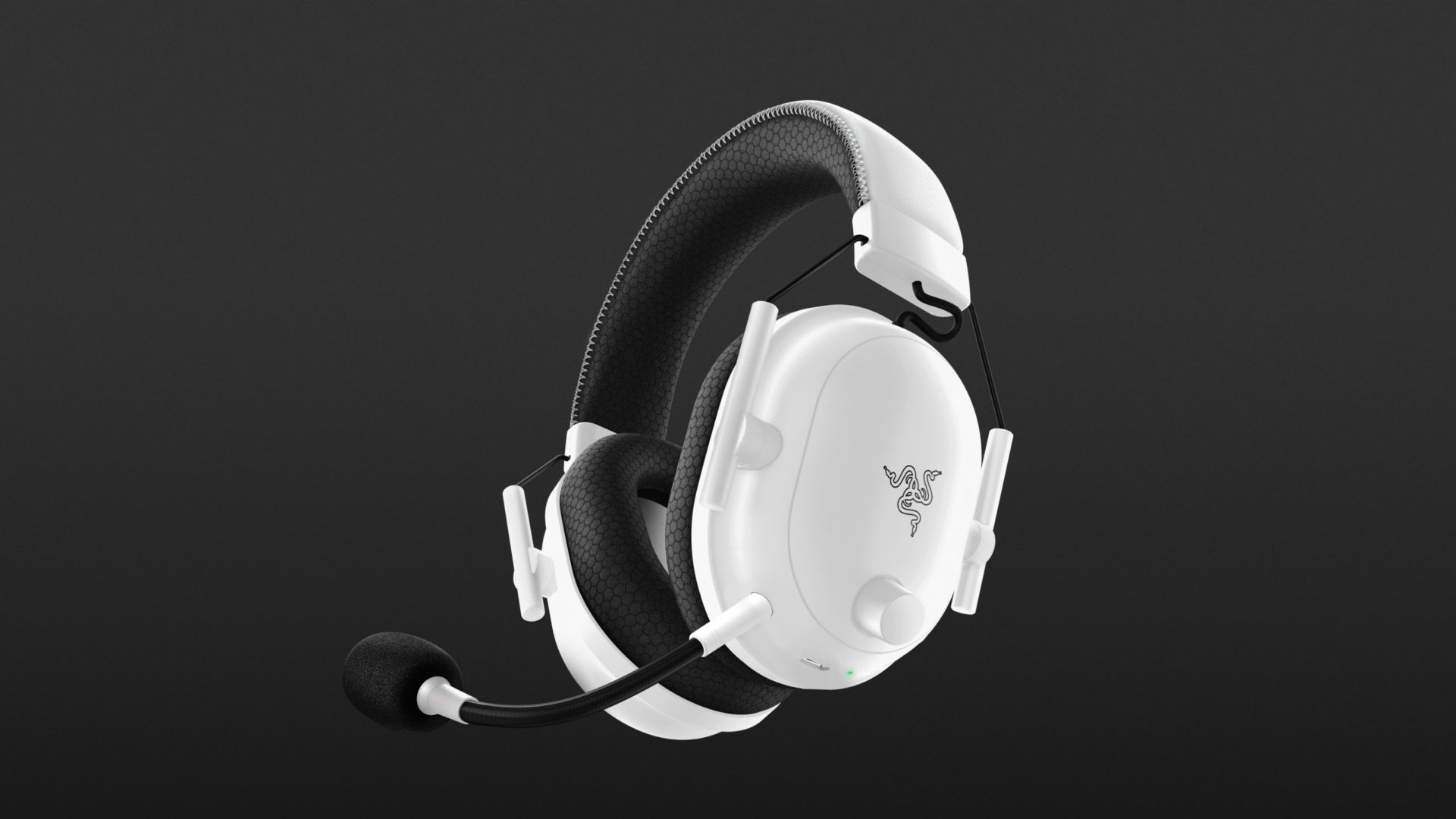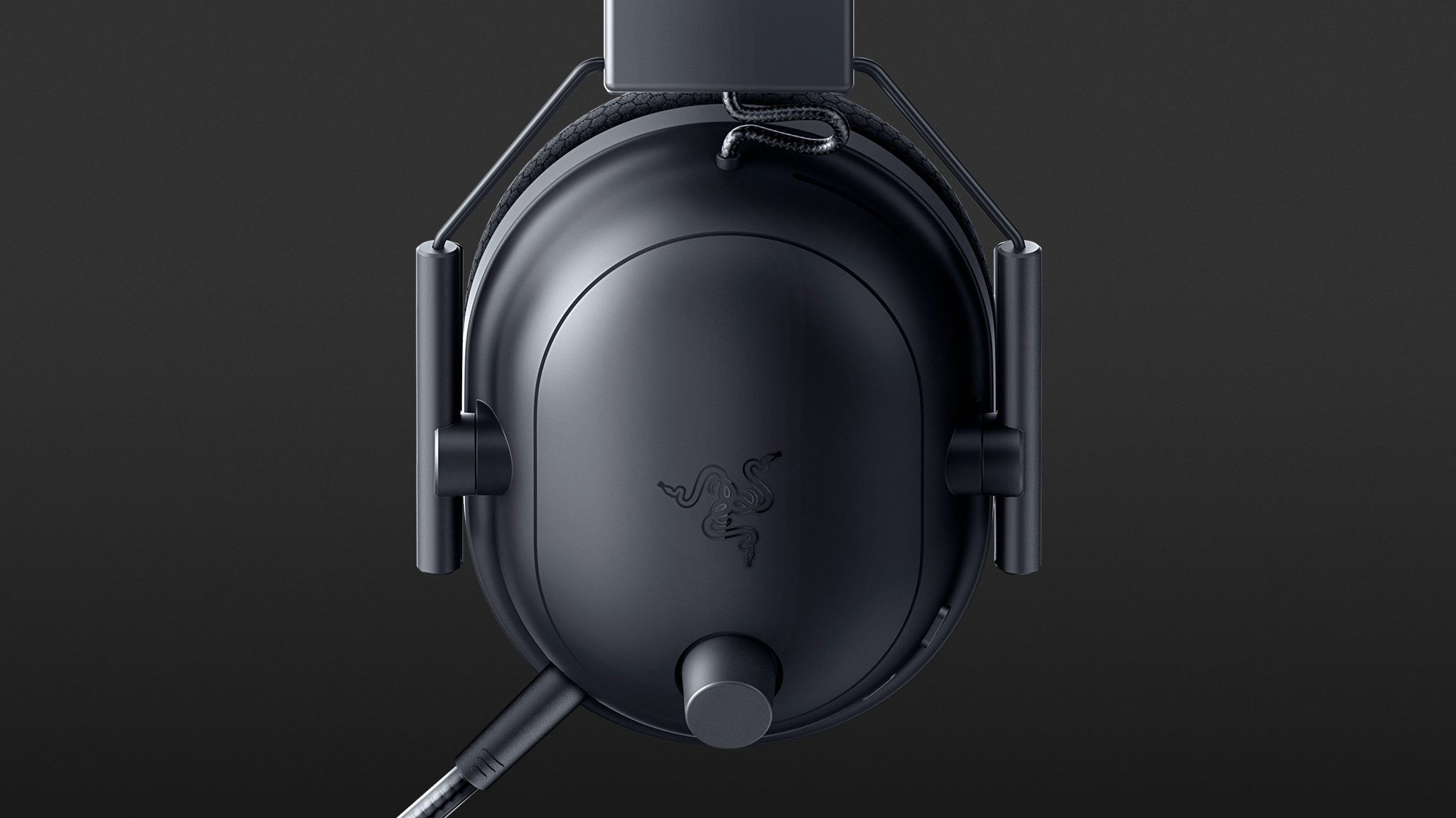With the BlackShark V2 Pro, Razer present a serious gaming headset for e-sports. Thanks to special FPS profiles, you can increase your perception in games to make it possible to hear opponents earlier so you can react faster. Although the Razer Synapse software is anything but streamlined, it still allows you to make detailed adjustments to adapt the headset to your own needs. The sound was certainly not high-end, and the basic sound was a little unbalanced for our taste, but the EQ helped to realise a personalised ideal sound quite well. Speaking of which, we didn’t like the inverted volume control, but Razer hit the mark when it comes to wearing comfort and the quality of the HyperClear Super Wideband microphone.
- Good sound with slight limitations
- FPS profiles
- long battery life
- very good speech intelligibility
- volume control is inverted
- bass not particularly pronounced
The Razer BlackShark V2 Pro 2023 is a serious gaming headset for e-sports enthusiasts. The FPS pre-sets that have been developed by professionals help you to perceive opponents better and faster when taking part in competitions. While the wearing comfort and the new HyperClear super wideband microphone are very good, the rather unbalanced basic sound requires manual intervention via the Razer Synapse software.
Razer have updated their BlackShark V2 Pro e-sports gaming headset: what’s new?
The headband and extension arm has been revised for increased comfort, the battery life has been extended to 70 hours, and the microphone has been technically upgraded. Micro-USB has become USB-C, and thanks to Bluetooth, you can simultaneously connect the BlackShark V2 Pro to a smartphone. One particularly practical feature is the FPS audio profiles, which were developed in cooperation with e-sports enthusiasts and can be selected directly on the headset – previously, this had to be done via the Synapse software.
Let’s dive deeper: Razer BlackShark V2 Pro
The Razer BlackShark V2 Pro gaming headset remains the same in terms of colour, design and build. These over-ear headphones are available in black or white; they come with a wireless dongle (“Hyperspeed Wireless”), USB-A extension cable and USB-A to -C charging cable.
Design & wearing comfort of the Razer BlackShark V2 Pro
The headset, whose design definitely has retro leanings, weighs 320 grams. The extremely soft, thick memory foam headband distributes the weight comfortably on your head while not applying too much pressure. Together with the breathable, almost 2cm thick memory foam ear pads, hours of wearing pleasure without pressure discomfort are ensured, even if you’re wearing glasses. Heat generation is kept within reasonable limits and as with the previous model, the pads can be replaced. On the inside, they offer space of approximately 6.2 by 4.2 centimetres.
The ear cup suspension is made of plastic, just like the ear cups themselves, and the delicate-looking metal suspension can be smoothly adjusted to fit your size. With an extension length of approx. 3.4cm on both sides, the Razer BlackShark V2 Pro offers sufficient room for those with large heads.
Fans of hoodies take note: The large ear cups are designed to absorb rubbing noises during “action on the ears”, but this can be slightly annoying in quieter passages of a game or when listening to music.
How well can the Razer BlackShark V2 Pro be operated?
The Razer BlackShark V2 Pro does not have many controls, so there is not a particularly steep learning curve, and it should be quick to pick up. On the left ear cup, the power button turns the headset on and off; a seven-second press puts the BlackShark into Bluetooth pairing mode, while the button above it mutes or arms the microphone. The large conveniently-placed rotary control on the side takes care of the volume. However, I found this control very unfamiliar as it was inverted. For decades, we have been turning the volume up clockwise and down counter-clockwise. It’s like that on mixers, amplifiers and other gaming headsets. So is there a specific reason for this behaviour that only e-sports enthusiasts know about?
- The volume control is easy to reach, but it is inverted.
On the right ear cup, there is only one button.This switches through the EQ pre-sets “Game”, “Movie”, “Music” and “Custom” or – after a three-second press – the “Pro-Tuned FPS Profile”. These EQ pre-sets, which are adapted to specific games, can then be switched through again. Razer offers sound adjustments for “Apex Legends”, “Call of Duty”, “CS:GO”, “Fortnite” and “Valorant”. According to the manufacturer, the FPS audio profiles were developed with e-sports players. The previous model also had something similar, but what’s new here is these special settings no longer have to be selected via the Synapse software but are stored directly on the headphones.
- The operation is easy to learn: On the left is the power/Bluetooth pairing button as well as the microphone switch, while on the right is the Smart Switch, or EQ switch.
Razer Synapse for Windows 10/11
If you already own a Razer gaming headset, the software hub is nothing new.
Related to the Razer BlackShark V2 Pro, Synapse allows you to set your sound relatively precisely and activate noise reduction or sidetone for the microphone. You can also link your installed PC games and assign individual sound behaviour to them. Two THX modes are available, “THX Environmental Mode” and “THX Competitive Mode”. The former lets you submerge yourself in the game world for immersive play. Mode two is about competitive advantages, i.e. when sound sources must be perceived quickly and clearly from their position. Of course, all other games for which there are no special profiles also benefit from this technology. Any installed games are recognised by the requisite Synapse software. This is also where you can choose which games should use the THX Spatial Audio.
How good is the HyperClear super-wideband microphone?
The manufacturer emphasises the technical revision of the microphone in particular. While the previous model’s microphones sampled at 16 kHz, the BlackShark V2 Pro Razer doubles the entire process to a sampling rate of 32 kHz. This means that 32,000 samples per second can be captured by the headset (thus frequencies up to a maximum of 16,000 Hz). According to the specs, the BlackShark V2 Pro’s built-in condenser microphone with its 9.9-millimetre diaphragms offers a frequency response of 100 Hz to 10 kHz. Recordings and testing with a spectrum analyser showed a strong frequency drop from 10 kHz. Meanwhile, the Synapse software offers an equaliser in the “Micro” tab that can boost or cut the 16 kHz band, which in practice only produced subtly better results.
In practice, the flexible microphone with plop protection was very impressive. Speech intelligibility on Discord, during Call of Duty or in video conferences was always impeccable. Together with the fine-tuning options in Synapse, you get a microphone performance that leaves very little to be desired.
The sound of the Razer BlackShark V2 Pro
Straight out of the box, the Razer BlackShark V2 Pro sounds relatively sober and unspectacular. The manufacturer has done without a hyped bass and instead places emphasis on the mid-range and treble. If you turn the headset up all the way, the upper mids and highs get a boost, but this can sound cutting to the ears (e.g. Neneh Cherry’s “Buffalo Stance”). If this is not what you want, you can counteract it with the Custom EQ, which is fortunately stored directly on the headphones.
The different EQ pre-sets “Game”, “Movie”, and “Music” are a good starting point and work well in practice, even if they don’t always fit one hundred per cent. However, you can also fine-tune the pre-set sound curves that have been adapted to specific purposes.
When playing games on Playstation 5, such as Horizon Forbidden West, the headset was impressive, but you have to accept stereo sound, as THX Spatial Audio is only available with Windows 10 64-bit or higher. In terms of sound, the Razer BlackShark V2 Pro on the PS5 translates Aloy’s gaming world well, even if, due to its design, this gaming headset is not able to reproduce the more subtle “micro noises” as precisely as an Audeze Maxwell.
The situation is somewhat different when using a gaming PC, as here, the FPS profiles come into play. While playing Fortnite, we activated the corresponding profile, and it was much easier to determine the position of opponents.
With THX Spatial Audio, however, we didn’t experience the wow factor we were hoping for. The THX demo film, which can be played in the Synapse software, sounded recognisably different (a little wider, more open and deeper). Nevertheless, this immersive sound expansion still played very much inside the tester’s head and not in front of it or around it. For us, this didn’t create as strong an extended spatiality as we would have liked.
But the Razer BlackShark V2 Pro was precise! In “THX Environmental Mode”, the gaming world became wider and more immersive. In “THX Competitive Mode”, meanwhile, sounds could be located well, and identification from above and below also worked well.
When it comes to films or music, speech intelligibility and details were not missing because this was well implemented by this headset, but due to the reduced bass, it lacked depth. The equaliser can be used to compensate for this to some extent, but you can tell that the Razer BlackShark V2 Pro was primarily created for competitive gaming.
The Razer BlackShark V2 Pro in practice
The Razer BlackShark V2 Pro connects quickly: Plug the HyperSpeed dongle into a free USB-A port on your PC and wait briefly for Windows to acknowledge that it is ready for use. However, the first thing to do is update. Both Razer Synapse and the headset’s firmware needed to be updated, which meant we had a wait of almost 20 minutes. After that, the Razer BlackShark V2 Pro was ready to be configured in Synapse.
By pressing the button on the right side of the ear cup for seven seconds, the headset initialised its Bluetooth pairing. Bluetooth version 5.2 is used, and here Razer – as usual – doesn’t use high-resolution codecs, preferring to rely on SBC and AAC. The latter worked smoothly with our iOS and Android devices, and while Spotify sent our test tracks to the BlackShark via iPhone, the wireless connection was paused via the HyperSpeed dongle. A double tap on the Profile/EQ button or a press on the Play button quickly and reliably switched back to Bluetooth. If the phone rings, you can comfortably make a call via the headset unless you have activated “Do not disturb” in Synapse. If that is the case, calls will not be forwarded.
The caller on the other end of the line confirmed very good voice quality during phone calls. Sibilants were neither sharp nor was there a lack of naturalness in your own voice.
During our test, we also used Windows 11 virtualised with VMware Fusion on a MacBook Pro. However, there were always problems when changing the EQ pre-sets because the headset simply did not respond. Restarting the VM remedied the situation for a few minutes, but it turned out that the Razer BlackShark V2 Pro just doesn’t like this combo.
Technical specifications
- Ear couplingOver-ear
- Typeclosed
- Transducer principledynamic
- Frequency response (headphones)12 - 28.000 Hz
- Impedance32 ohms
- Sound pressure level (SPL)@ 1 kHz/1 mW: 100 dB
- Weight without cable320 g
- Cable length200 cm
What's in the box
- detachable microphone
- Wireless dongle
- USB-A adapter cable
- USB-C to -A charging cable
Special features
- Available in black and white
- BT codecs: SBC, AAC
- BT version: 5.2












































